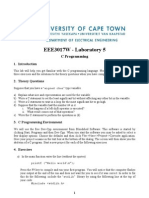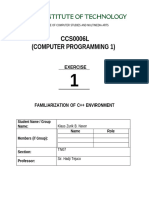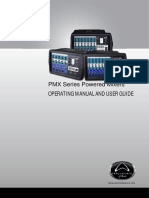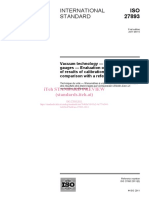Lab 1 Introduction To Linux Environment and C Compiler
Uploaded by
syazaa syazaaLab 1 Introduction To Linux Environment and C Compiler
Uploaded by
syazaa syazaaEKT 120 Introduction to Computer Programming
Laboratory Module
LAB 1
INTRODUCTION TO LINUX ENVIRONMENT AND C
COMPILER
School of Computer and Communication Engineering
Universiti Malaysia Perlis
1
EKT 120 Introduction to Computer Programming
Laboratory Module
1. GETTING STARTED:
1.1 Steps to Create New Folder:
1.1.1 Click Places icon > Home Folder > Go to File menu > Create Folder
1.1.2 Rename the New Folder as your Matrix No.
1.2 Steps to Start the Text Editor:
1.2.1 Click Applications icon > Accessories > Text Editor (you are now in
gedit editor).
1.2.2 Once the gedit text editor started, automatically it will view an untitled
program.
1.3 Steps to Create New Program in gedit:
1.3.1 Type the following program:
// Program Example 1
// This program displays message "Welcome to UniMAP
#include <stdio.h>
int main()
{
printf("\nWelcome to UniMAP\n");
return 0;
}
1.3.2 Once finished, save the program file or also known as the source file.
1.4 Steps to Save the Source File:
1.4.1 Go to File menu, select Save as option.
1.4.2 Save the file as welcome.c. Type welcome.c in the box besides the
Name location.
OR
if you want to save in a specified folder, select the folder in the save as
dialog box.
(e.g. /home/student/foldername), double click the folder icon and then
type welcome.c in the box besides the Name location. Click Save button.
Notes : The filename must be in one word with extension .c, for
example Program.c or pgm_1.c.
1.5 Steps to Compile a Program:
1.5.1 Click Applications icon > Accessories > Terminal
1.5.2 Use the following commands to check the source file location:
pwd
- command to check the current directory
ls
- to list down the files in the current directory.
cd directory - to change directory
1.5.3
If you have found your file, use the command gcc to compile the
program welcome.c
gcc welcome.c
EKT 120 Introduction to Computer Programming
Laboratory Module
Note: after compiling using the above command, if there is no error
a default binary file, a.out is created. This is an executable file.
1.5.4
You can also compile the program and specify the output file (the
executable file) name together with the compile command. This is to
specify or named your binary file related to your program.
gcc -o welcome.out welcome.c
OR
gcc welcome.c -o welcome.out
Note: use the o parameter to specify the output file, followed the
filename that you want to specify.
1.6 Steps to Execute or Run the Program.
1.6.1 In the Terminal window, at the command prompt, run the binary file.
1.6.2
To run the default output (or binary) file, type:
./a.out
Note: the ./ to specify the binary file is in the current directory.
OR
To run the specific output (or binary) file, type:
./welcome.out
When you run the file, the output should be:
Welcome to UniMAP
CONGRATULATIONS!!!! You are now able to write and run your first program
successfully.
EKT 120 Introduction to Computer Programming
Laboratory Module
2. TASKS
Now you have learned to compile a simple C program, try to answer the following
questions:
2.1 True or False:
a.
In general, C statement is case sensitive
Ans:
b.
The name of the primary function of a C program must be main Ans:
c.
main ( ) { } is a complete and correct C program.
Ans:
2.2 Find error(s), if any, in each statement:
a.
void main (void);
b.
printf (Do we need parentheses here?);
c.
Printf(Is there any wrong here?);
d.
printf(Where do we need a blank space)
2.3 Type, compile and run this program, correct any error(s) you may find and rewrite
the program.
main(
{printf (There is no class tomorrow
);
2.4 Determine and correct any error(s) you may find in the following command.
ma
in() PRINTF *, (What is wrong?);
EKT 120 Introduction to Computer Programming
Laboratory Module
2.5 Type the following program.
#include <stdio.h>
void main (void)
{
int dA;
float fB;
dA = 2;
fB = 3.0;
printf(Learning Basic Structure of C Language);
printf(dA + fB = %f, dA+fB);
}
a. Compile the above program and write down the comment given on the screen
after compiling.
b. Compile the above program to specify the output (binary) to a filename
basic.out and then run the output file. Write the command that you use to
complete the above instruction
c. Write down the output of the program.
d. Format the floating number into 8 numbers and 2 floating point. Write down the
formatting format you use.
e. Correct the program so that the output looks presentable. Describe the changes
you have done and the output of the program.
i.
Write down the changes done to the program:
EKT 120 Introduction to Computer Programming
Laboratory Module
ii. What is the output of the program?
f.
Change the first void to int, then compile the program. Write down any
message after compiling.
g. Explain the program in your own word and describe the command from top until
end of the program.
You might also like
- C# For Beginners: An Introduction to C# Programming with Tutorials and Hands-On ExamplesFrom EverandC# For Beginners: An Introduction to C# Programming with Tutorials and Hands-On Examples5/5 (1)
- Lab 1 Introduction To Linux Environment and C CompilerNo ratings yetLab 1 Introduction To Linux Environment and C Compiler6 pages
- Module 1: Running The C Program Using Code::BlocksNo ratings yetModule 1: Running The C Program Using Code::Blocks8 pages
- EKT 150 - Introduction To Computer Programming Lab 2No ratings yetEKT 150 - Introduction To Computer Programming Lab 29 pages
- CSE_1081 - Problem Solving Using Computers Lab ManualNo ratings yetCSE_1081 - Problem Solving Using Computers Lab Manual222 pages
- Learning About Compiler Installation, Basic C Program, Basic Data Types, Basic Input or Output and The Use of VariablesNo ratings yetLearning About Compiler Installation, Basic C Program, Basic Data Types, Basic Input or Output and The Use of Variables14 pages
- PW 1: Discovering The Environment: GoalsNo ratings yetPW 1: Discovering The Environment: Goals3 pages
- Exercise 1 - Compiling Your First C Program: Printf /N PrintfNo ratings yetExercise 1 - Compiling Your First C Program: Printf /N Printf3 pages
- mcsl-17 C and Assembly Language Programming LabNo ratings yetmcsl-17 C and Assembly Language Programming Lab42 pages
- Z00810020120164088COMP6047 (T) Pert 5 - Introduction To C ProgrammingNo ratings yetZ00810020120164088COMP6047 (T) Pert 5 - Introduction To C Programming24 pages
- Lab Report On C-Programming Lab No.: 1 To 12 Title: Introduction and Variables Date: 2079/01/16No ratings yetLab Report On C-Programming Lab No.: 1 To 12 Title: Introduction and Variables Date: 2079/01/16199 pages
- The Importance of Bulk Liquid Storage - Chemical Industry JournalNo ratings yetThe Importance of Bulk Liquid Storage - Chemical Industry Journal5 pages
- Introduction To Burger Kings Levels of Management100% (1)Introduction To Burger Kings Levels of Management10 pages
- 630 01918 01 - 01.13 - 2.0 NUViA Supported TerminalsNo ratings yet630 01918 01 - 01.13 - 2.0 NUViA Supported Terminals56 pages
- Poulami Mukhopadhyay: Professional SummaryNo ratings yetPoulami Mukhopadhyay: Professional Summary4 pages
- CT Supralight: Engines: CTSL - 912 CTSL - 912S CTSL - 912is CTSL - 914T Avionics: Basic AdvancedNo ratings yetCT Supralight: Engines: CTSL - 912 CTSL - 912S CTSL - 912is CTSL - 914T Avionics: Basic Advanced4 pages
- Nova Ran Optimization - Ran Overview: Sofian Ben Khalifa 14/nov/2017No ratings yetNova Ran Optimization - Ran Overview: Sofian Ben Khalifa 14/nov/201719 pages
- Level-And Temperature Sensor Nivotemp NT 63: FluidcontrolNo ratings yetLevel-And Temperature Sensor Nivotemp NT 63: Fluidcontrol4 pages
- AOC Service Manual HP-L1740 - A00 Monitor LCD100% (1)AOC Service Manual HP-L1740 - A00 Monitor LCD92 pages
- Fabrication Requirements For Radiant Coils of SCORE FurnacesNo ratings yetFabrication Requirements For Radiant Coils of SCORE Furnaces10 pages
- C# For Beginners: An Introduction to C# Programming with Tutorials and Hands-On ExamplesFrom EverandC# For Beginners: An Introduction to C# Programming with Tutorials and Hands-On Examples
- Lab 1 Introduction To Linux Environment and C CompilerLab 1 Introduction To Linux Environment and C Compiler
- Module 1: Running The C Program Using Code::BlocksModule 1: Running The C Program Using Code::Blocks
- EKT 150 - Introduction To Computer Programming Lab 2EKT 150 - Introduction To Computer Programming Lab 2
- CSE_1081 - Problem Solving Using Computers Lab ManualCSE_1081 - Problem Solving Using Computers Lab Manual
- Learning About Compiler Installation, Basic C Program, Basic Data Types, Basic Input or Output and The Use of VariablesLearning About Compiler Installation, Basic C Program, Basic Data Types, Basic Input or Output and The Use of Variables
- Exercise 1 - Compiling Your First C Program: Printf /N PrintfExercise 1 - Compiling Your First C Program: Printf /N Printf
- Z00810020120164088COMP6047 (T) Pert 5 - Introduction To C ProgrammingZ00810020120164088COMP6047 (T) Pert 5 - Introduction To C Programming
- Lab Report On C-Programming Lab No.: 1 To 12 Title: Introduction and Variables Date: 2079/01/16Lab Report On C-Programming Lab No.: 1 To 12 Title: Introduction and Variables Date: 2079/01/16
- The Importance of Bulk Liquid Storage - Chemical Industry JournalThe Importance of Bulk Liquid Storage - Chemical Industry Journal
- 630 01918 01 - 01.13 - 2.0 NUViA Supported Terminals630 01918 01 - 01.13 - 2.0 NUViA Supported Terminals
- CT Supralight: Engines: CTSL - 912 CTSL - 912S CTSL - 912is CTSL - 914T Avionics: Basic AdvancedCT Supralight: Engines: CTSL - 912 CTSL - 912S CTSL - 912is CTSL - 914T Avionics: Basic Advanced
- Nova Ran Optimization - Ran Overview: Sofian Ben Khalifa 14/nov/2017Nova Ran Optimization - Ran Overview: Sofian Ben Khalifa 14/nov/2017
- Level-And Temperature Sensor Nivotemp NT 63: FluidcontrolLevel-And Temperature Sensor Nivotemp NT 63: Fluidcontrol
- Fabrication Requirements For Radiant Coils of SCORE FurnacesFabrication Requirements For Radiant Coils of SCORE Furnaces

























































































